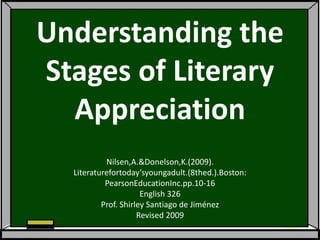
Understanding the stages of literary appreciation
- 1. Understanding the Stages of Literary Appreciation Nilsen,A.&Donelson,K.(2009). Literaturefortoday’syoungadult.(8thed.).Boston: PearsonEducationInc.pp.10-16 English 326 Prof. Shirley Santiago de Jiménez Revised 2009
- 2. What is literary appreciation?
- 3. It is the ability to: gain pleasure and understanding for literature understand the value and importance of literature esteem, honor, respect, and/or admire the beauty and complexity of literature
- 4. What is Literature? Literature (Big L) Classics that have been read over and over again or have been acclaimed throughout the years (literary awards) Works that are considered exemplary because they provide knowledge and understanding of the world and man.
- 5. What is literature? literature (little l) Broadly, anything that is written (such as novels, poems, plays , and articles) Written works with popular appeal
- 6. What are the stages of literary appreciation? They are an approximation of the different levels of “ how individuals develop the personal attitudes and reading, watching , and listening skills that are a necessary part of literary appreciation.”
- 7. Each developmental stage or level (Nilsen and Donelson, 2009) is characterized by : •An optimal age (or grade level) •Sample literary materials •Sample actions or activities
- 9. Level 1: Understanding that Pleasure and Profit Come from Literature ( Ages 0-5: Pre-School) Literature can refer to oral manifestations (songs and nursery rhymes) as well as graphic or visual depictions (picture books, television programs, and appealing signs)
- 10. The literary experience is a social one Adults sharing; going to bookstores and libraries; talking about T.V. programs and movies Children have opportunities for “talking stories" and “grand conversations”
- 11. Level 2: Learning to Read (Decode) (Ages 6-8: Grades 1-3) Children are developing literacy (“…a process that is never-ending for anyone who is intellectually active.”) One must not lose sight of those children who are struggling with literacy and subsequently lose sight of the search for pleasure and enjoyment
- 12. Those children who learn to read easilyare undemanding and in a stage of “unconscious enjoyment” –becoming addicted to one particular book or character (allowing for the development of speed and skill)
- 13. Level 3: Losing Oneself in a Story (Ages 9-11: Grades 4-6 ) Time outside of school for reading, less television time, and uninterrupted conversation is essential. (Distractions do not help to develop appreciation for reading!) Children read while engaged in other activities.
- 14. Reading can become a means of “escaping.” This developmental stage may not occur until much later than the 4th or 5th grades, or it may not happen at all.
- 15. Level 4: Finding Oneself in a Story (Ages 12-14: Junior High) Adolescence At this stage, the more experience young people have with literature (books or movies), the more discriminatingthey become. To receive pleasure, they have to respect the story; it has to be real!
- 16. They want to know not what happened , but why; stereotypes are no longer satisfying; characters have to be believable. They are reading to find out about themselves, not simply to escape into someone else’s experiences.
- 17. They are looking for lives as much like their own as possible. In addition, they are curious about other sides of life ( e.g. the bizarre, the unbelievable, the grotesque) Their purpose is largely that of finding themselves and where they fit in society. The Bottom Line: Reading is a means of discovering identity.
- 18. Level 5: Venturing Beyond Self (Ages 15-18: High School) The person goes beyond his/her egocentrism and looks at the larger circle of society (“going beyond me”). Issues such as conformity, social pressures, justice, and human weaknesses and strengths
- 19. Teenagers are responsible for assessing the world around them and where they fit in. This stage is more about emotional, intellectual and physical development instead of advanced reading skills.
- 20. Reading at this level allows for focusing on the person’s psychological needs in relation to society. (Science fiction and fantasy help to create new ideas about the existing society.)
- 21. Levels 6 and 7: Reading Widelyand Aesthetic Appreciation (Ages 18 - Death) At the college level, the young adult reads best-sellers and is involved in acclaimed literary works such as novels, plays, and films, sharing these experiences with peers.
- 22. Throughout adulthood, the avid reader who has developed the skills and attitudes necessary to enjoy literary experiences at all the previous levels, is ready to embark on a lifetime of aesthetic appreciation (understanding the beauty and artistic value).
- 23. What is the importance of understanding the different stages of literary appreciation? In order to appreciate literature, people at any stage must experience pleasure and profit from their reading, viewing, and listening. As (future) teachers and parents, we must meet young people where they are and help them feel comfortable before trying to move them on.
- 24. The Goal: A society of adults who are intellectually stimulated to read for personal fulfillment and pleasure and understand that it is beneficial!
